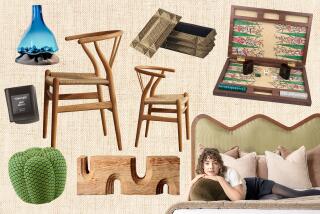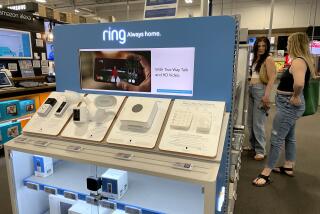Wired! : A home today can be almost the same as a home of the future if you have the money. Electronics will let you do anything, even put a TV in your shower.
If “The Jetsons” used to be part of your Saturday morning TV ritual, it’s a fair bet that you also used to dream about having a few of George Jetson’s household gadgets to monkey around with.
George would push a button and out of the ceiling would come the TV. He’d tell a machine to brew him up a cup of coffee and there it would be, piping hot. If he wanted to check on the kids, he just poked a button on the TV remote and there on the screen would appear Judy and Elroy in their respective rooms. And, of course, the Jetson family had a robot.
If you ever coveted all that stuff, you may be in for a surprise. Today, you can have it, just about all of it, along with a few gimmicks even George never dreamed of. Because compared to the current innovations in electronic home conveniences, the future--as seen in the ‘60s, anyway--looks positively old hat.
Consider, for instance, the Mastervoice Series II, which enables you to walk through the door after work, tell the air conditioner to kick in, tell the coffee pot to heat up, tell the stereo in the bedroom to begin playing and order the pool lights to switch on. Verbally.
Consider also Tom and Joyce Tucker of Laguna Beach. Tom is a rabid movie fan, and his idea of bliss at home is an in-house theater. So he had one built, complete with a 100-inch front-projection TV, two VCRs, a compact disc and laser disc player and surround-sound speakers. To put an even finer point on the sound, Tucker also had the ceiling and walls padded.
Tucker didn’t stop there. He decided he wanted to be able to watch TV even when he was showering. So he had one installed in the wall of his shower, behind two layers of glass. A small but powerful fan behind the television keeps the glass from fogging. Waterproof speakers were installed flush with the shower wall, and a waterproof telephone also was put in. Tucker said he can watch TV in the shower while his wife is listening to music from the built-in stereo speakers elsewhere in the bathroom.
The Tucker home also was fitted with a system of low-voltage computerized lighting. Tucker said all the lights in the house can be programmed to “set scenes” in any room depending on the time of day.
Interior designers say they are beginning to hear from more clients like the Tuckers, people who have heard that home electronics now means much more than just a computer in the den.
“People will call and say, ‘I want the bells and whistles.’ That’s what they’ll call” the new devices, said Patricia Mickey, an interior designer and owner of PMA Design Group in Costa Mesa. “As science and industry make bigger steps, it’s being felt down at our level more than it used to be. Things that used to be thought of as futuristic are actually happening. I saw the movie ‘2001’ again about a year ago and it was almost comical. We’ve gone beyond that already in so many areas.”
Indeed, the idea of the “electronic cottage,” a notion from the ‘80s that implied that most of the doings in one’s life could be controlled electronically without leaving home, is already beginning to seem limited.
A quick tour of an imaginary house, thoroughly tricked out with the latest gadgetry, can be almost breathtaking. As you approach the front door, you might want to smile and say hello, since you’re being picked up on a closed circuit television camera with sound. The picture can be seen on a neutral channel of any TV in the house. The CCTV Corp. of New York makes one of these for about $400.
See that cat door installed in the front door? The family cat is the only animal that can get through it, thanks to an electronic “key” built into his collar that triggers a sensor in the door, causing it to open. Strays can’t get in. Best Friend Products of Doylestown, Pa., sells it for about $142.
OK, you’re in the door. Did you notice how the lights came on? You never had to touch a switch. You were spotted by a passive infrared sensor, known as a PIR, a device that designers say is becoming more common in home use. Honeywell makes one that wires into the wall like a light switch and costs about $48. It doesn’t see you, but rather senses your motion and your body heat in the room.
Stanley Home Automation also offers a light control (about $59) that is sensitive to motion indoors and out and also will turn lights on automatically at dusk and off at dawn. (Something a bit cheaper: a photosensitive night light that comes on automatically in the dark. Honeywell makes it for about $6.50).
PIR technology has seen some fairly singular applications, particularly in the area of home security systems. The Heath Co., for instance, sells the Barking Dog Security System (about $60). When the PIR sensor notices a body in the room, it emits a realistic dog bark. And for about $180 you can get a similar barking dog system that can “see” through solid objects like wooden doors (the Ram Corp. sells it).
Let’s have a look at the coffee table in the living room. There it sits, right at knee level, looking very much like what it is, until you flip a switch and activate a set of hydraulics that raises it to the level of a dining table. Mickey said she installed one of them recently in a condominium whose owner had little space but a lot of imagination. In fact, she said, the use of both hydraulic and electric lifts and motors for various pieces of furniture and appliances is on the rise as more technicians are learning how to install them.
“When we first started doing these things several years ago,” she said, “you had to really look for a cabinet shop that knew what to do with the hydraulic stuff. Now they’re not as hard to find, and the state of the art on the mechanisms is getting so much better. For instance, when we first started doing electric blinds, there were these big, bulky motors. Now they’re much smaller.”
When homeowners originally became enamored of hydraulics and electrically manipulated items, “it was just a space thing,” Mickey said. “They wanted things hidden because there was no space to show them. Recently, though, it’s aesthetics as well. It’s not having a television hanging out and looking like a television. Instead, there will be a beautiful cabinet and the television rises out of it. The cabinet can be designed as a focal point on its own.”
Which brings us to the den. Or, in the latest incarnation, the “home theater.” You might know it as the place that houses the “media center,” that great mass of wires and screens and capstans and drives and lights and dials and remotes in one end of the room, dominated by a big-screen TV. Now imagine all that hardware gone--or at least camouflaged.
Tim Shepard does this for a living. The owner of Audio-Video Environments in Orange, Shepard specializes in installing home entertainment systems in often undetectable ways.
“We’re basically trying to make it aesthetically pleasing as well as functional,” Shepard said. “We’ll try to hide things into some kind of design element, either in interior design or in architectural elements. A lot of people don’t want to see the individual components themselves. Some people like a room that’s like a theater--more intimate, with warmer lighting. Others like to have it as a multipurpose room, where you push a button, everything goes up and you don’t see anything.”
This means, again, motors. It’s possible, Shepard said, to install both a large front-projection TV and its projector in such a way that they are hidden from view until a motor is activated and they lower from the ceiling or from another overhead spot.
“You can motorize anything you want,” he said, “a projector, a screen. The bottom of the screen can be the bottom of an overhead beam, for instance. At the Playboy mansion (in Los Angeles), the screen comes out of a molding treatment on the wall. Or you can put the whole system into a wall.”
It’s also possible to hide components that are usually thought of as having a rather high profile: speakers. A company called Sonance in San Clemente is well-known for its speakers, both full-size and small-format, that can be hidden in walls or built into some other design element in the house.
Sonance made the speakers in Tom Tucker’s shower and Shepard said he managed to raise the camouflage to an even higher level by concealing the speakers in a bogus supporting column in a room.
Anything that can be done in the living room or the den--or, actually, just about any room in the house--can also be done in the bedroom, and often is, Shepard said: Screens recessed in the ceiling at the foot of the bed, entire media centers, electronic boxes at bedside that control lights throughout the house, motorized drapes that can sense the level of light in the room and automatically open or shut accordingly.
Still, you have to turn to the bathroom for a look at truly head-shaking indulgences. For instance, if a nice hot bath seems the height of pampering to you, you can now go higher still. You don’t have to draw your own bath or test the water. The Autofill Bath System (sold by the Kohler Co. of Wisconsin for about $700) can be programmed to have your bath ready at any time and at your favorite temperature.
Think you can’t do anything to jazz up the toilet? Think again.
A company called Toto Kiki USA Inc. (the American branch of Toto Ltd. of Japan) has produced a prototype of a toilet they call the Medical Queen.
It has, among other personal functions, a heated seat and will also take your pulse and blood pressure and provide a urine analysis that measures protein, sugar and red and white cell counts. It can store two months’ worth of this medical data and can transfer the data to a hospital over telephone lines.
Ross Beck, the company’s marketing manager, said the Medical Queen is not yet available, even in Japan.
Now the clincher. Remember the Mastervoice Series II? It can control almost everything--the lights, the VCR, the burglar alarm, the stereo, the bath, the sprinklers, the heating, the coffee. Almost anything electronic. And you don’t have to be home to do it. You can perform all those tasks from anywhere in the world with a touch-tone phone.
The device is a small black box fitted with a microphone and a speaker that can be programmed to control the functions of more than 300 household electronic items, from the table lamp to the microwave oven. Many of the functions must be performed manually by using a key pad (or the touch-tone phone if you’re elsewhere), but 64 devices can be controlled though the use of timers and another 42 can be activated by your voice alone.
The Series II, said Linda Zazueth, the sales and marketing administrator for Mastervoice Inc. in Los Alamitos, will not only understand your voice, but will answer you in your voice, your friend’s voice, or any voice you want to program into it. The company, she said, has produced voice cartridges that answer in voices of cowboys, witches and recognizable celebrities.
It also will understand the voices of three other people, speaking in any language.
“One guy who bought one calls his (machine) ‘God,’ ” Zazueth said. “And it answers, ‘Yes, my son.’ ”
It is also possible, Zazueth said, to activate 64 functions with a single voice command--”I’m home,” for instance.
“You can say that and turn on the chandelier, dim the bedroom lights, turn on the hall lights, start up the Jacuzzi, put on the coffee and turn on the air conditioner at the same time,” she said.
And, with a touch-tone phone, you can do all that from anywhere in the world.
The Series II costs about $4,000.
And, if you think irony doesn’t exist in the electronics world, it helps to know that the inventor of the Series II, Gus Searcy of Yorba Linda, used to be a magician.
More to Read
Inside the business of entertainment
The Wide Shot brings you news, analysis and insights on everything from streaming wars to production — and what it all means for the future.
You may occasionally receive promotional content from the Los Angeles Times.










